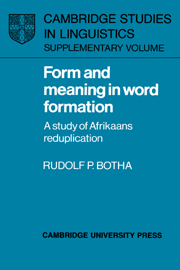Summary
This chapter provides further clarification of the manner in which the proposed theories of the formation and interpretation of Afrikaans reduplications are linked. The formation rule (2) of $2.1 copies all nouns (including cardinals), verbs, adjectives and adverbs, subject to the general constraints presented in Chapter 2 above. To each reduplication formed by this rule, the interpretation rule (1) of 3.1 assigns the semantic unit [INCREASED A]. This semantic unit is developed further by the conceptualization rules proposed in Chapter 3 above.
Note that the formation rule and the interpretation rule jointly generate a large number of reduplications that are unacceptable to native speakers. A significant subset of these unacceptable reduplications, being conceptually ill-formed, are filtered out by the conceptualization rules. That is, a subset of the reduplications generated jointly by the formation and interpretation rules are formally well-formed, but are unacceptable because the concepts corresponding to them are characterized as ill-formed by the conceptualization rules. The projected referents of such reduplications cannot be conceptualized in a coherent manner on these rules.
A few examples may serve to illustrate the filtering function of the conceptualization rules.
(a) *Hy woon in Parys–Parys. he live in Paris Paris “*He is living in a number of Parises.”
(b) *Sorg–sorg is hier nodig. care care is here required “*Scattered care is required here.”
(c) *Hy woon–woon in Parys. he live live in Paris “*He continually lives in Paris.”
- Type
- Chapter
- Information
- Form and Meaning in Word FormationA Study of Afrikaans Reduplication, pp. 153 - 157Publisher: Cambridge University PressPrint publication year: 1988



